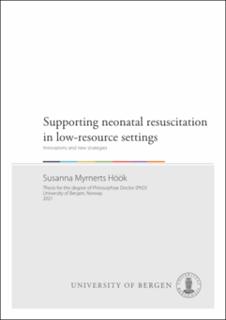| dc.contributor.author | Höök, Susanna Myrnerts | |
| dc.date.accessioned | 2021-04-30T08:41:08Z | |
| dc.date.available | 2021-04-30T08:41:08Z | |
| dc.date.issued | 2021-05-12 | |
| dc.date.submitted | 2021-04-15T09:31:04.489Z | |
| dc.identifier | container/30/53/55/99/30535599-cf7a-432a-9bf9-6210d22db4c3 | |
| dc.identifier.isbn | 9788230855881 | |
| dc.identifier.isbn | 9788230849194 | |
| dc.identifier.uri | https://hdl.handle.net/11250/2740511 | |
| dc.description.abstract | Background: Lack of oxygen at birth, birth asphyxia, accounts annually for around 700 000 deaths. Heart rate is important in evaluating a neonate and effective positive pressure ventilation (PPV) may prevent neonatal deaths. Evaluating heart rate by auscultation may be inaccurate and standard face-mask ventilation (FMV) may be inadequate. NeoTap Life Support (NeoTapLS) is a free-of-charge smartphone app for heart rate recording designed for low-resource settings. The laryngeal mask airway (LMA) is a tube used as an alternative to a face mask. Both of these innovations may be task-shifted to midwives who are on the front-line of neonatal resuscitation in low-resource settings. This thesis reports on investigations into whether these innovations and new strategies can potentially increase adherence to guidelines and thereby reduce neonatal mortality and morbidity.
Methods: Two observational studies and a clinical trial were conducted in Sweden and Uganda between 2014 and 2019. We investigated the accuracy and speed of heart rate assessment by NeoTapLS compared to a manikin, a metronome, pulse oximetry and electrocardiography, in simulations and in clinical use. A phase III open-label superiority randomized clinical trial, the NeoSupra Trial, compared LMA with face mask as a primary device for neonatal resuscitation carried out by midwives. The study involved neonates at ≥34 weeks of gestation and/or an expected birth weight of ≥2000 gram, thereby requiring PPV at birth. The primary outcome was a composite of 7-day mortality and moderate-to-severe hypoxic-ischemic encephalopathy, daily evaluated by Thompson scoring through Day 5.
Results: Simulation studies showed a high correlation between measured and true values. In the manikin study, 93.5% of the auscultations and 86.3% of the palpations differed by ≤5 beats, mean acquisition time 14.9 vs. 16.3 s. In the metronome study, 77% differed by ≤10. In clinical assessment by doctors of neonates not needing PPV 88% differed by ≤10 and by midwives in neonates needing PPV 48% differed by ≤10, median acquisition time 5 vs. 2.7 s. NeoTapLS showed very good sensitivity and specificity in detecting heart rate <100 bpm. The NeoSupra Trial had a complete follow-up data of 99.2%; the primary outcome occurred in 27.4% in the LMA arm and 24.4% in the FMV arm (adjusted relative risk, 1.16; 95% confidence interval 0.90 to 1.51; P=0.26). Seven-day mortality was 21.7% in LMA and 18.4% in FMV (adjusted relative risk 1.21; 95% confidence interval, 0.90 to 1.63). The proportion of moderate-to-severe HIE was 11.2 vs. 10.1% (adjusted relative risk, 1.27; 95% confidence interval, 0.84 to 1.93). Intervention-related adverse events were few and similar between the arms.
Conclusion: NeoTapLS is well adapted in the context it was used for swift and accurate heart rate recording by doctors. Clinical assessment by midwives was less accurate, suggesting that they may benefit from auscultation-focused training. LMA was safe in the hands of midwives but was not superior to a face mask in reducing early neonatal death and moderate-to-severe hypoxic-ischemic encephalopathy. It is suggested further investigations of these innovations and new strategies to explore the possibility of task-shifting its use to midwives in low-resource settings. | en_US |
| dc.language.iso | eng | en_US |
| dc.publisher | The University of Bergen | en_US |
| dc.relation.haspart | Article I: Myrnerts Höök S, Pejovic NJ, Marrone G, Tylleskär T, Alfvén T. Accurate and fast neonatal heart rate assessment with a smartphone-based application – a manikin study. Acta Paediatrica 2018;107:1548‐1554. The article is available at: <a href=" https://hdl.handle.net/1956/19656 " target="blank">https://hdl.handle.net/1956/19656 </a> | en_US |
| dc.relation.haspart | Article II: Myrnerts Höök S, Pejovic NJ, Cavallin F, Lubulwa C, Byamugisha J, Nankunda J, Tylleskär T, Alfvén T. Smartphone app for neonatal heart rate assessment – an observational study. BMJ Paediatrics Open 2020;0:e000688. The article is available at: <a href=" https://hdl.handle.net/11250/2740485" target="blank">https://hdl.handle.net/11250/2740485</a> | en_US |
| dc.relation.haspart | Article III: Pejovic NJ, Myrnerts Höök S, Byamugisha J, Alfvén T, Lubulwa C, Cavallin F, Nankunda J, Ersdal E, Blennow M, Trevisanuto D, Tylleskär T. A randomized trial of laryngeal mask airway in neonatal resuscitation. The New England Journal of Medicine 2020;383:2138-47. The article is not available in the thesis file due to publisher restrictions. The article will be available at: <a href=" https://hdl.handle.net/11250/2740498" target="blank">https://hdl.handle.net/11250/2740498</a> | en_US |
| dc.rights | Attribution-NonCommercial-NoDerivs (CC BY-NC-ND). This item's rights statement or license does not apply to the included articles in the thesis. | |
| dc.rights.uri | https://creativecommons.org/licenses/by-nc-nd/4.0/ | |
| dc.title | Supporting neonatal resuscitation in low-resource settings : Innovations and new strategies | en_US |
| dc.type | Doctoral thesis | en_US |
| dc.date.updated | 2021-04-15T09:31:04.489Z | |
| dc.rights.holder | Copyright the Author. | en_US |
| dc.contributor.orcid | https://orcid.org/0000-0001-7560-4077 | |
| dc.description.degree | Doktorgradsavhandling | |
| fs.unitcode | 13-26-0 | |

